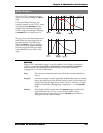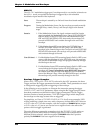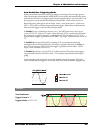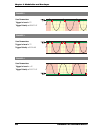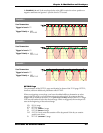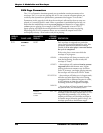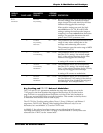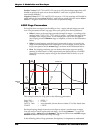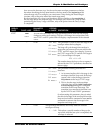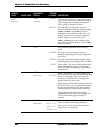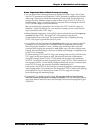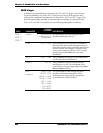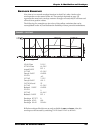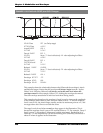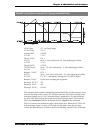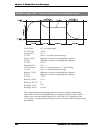
Chapter 6: Modulation and Envelopes
ANDROMEDA A6 REFERENCE MANUAL 161
how we use the the term stage. It refers to the same envelope parameters as before,
but when describing the loop start function, the loop starts at the beginning of the
selected stage only. For example, you cannot start a loop during the Attack stage’s
rise time, only at the point where the Attack stage starts.
By the same token, for a loop’s end functions, the loop finishes at the completion of
the last stage before the loop end stage. For example, you cannot end a loop at some
point during the Decay 2 stage’s fall time, only at the point where the Decay 2 stage
is completed.
DISPLAY
PAGE PANEL LABEL
PARAMETER
DISPLAY
OPTIONS
or RANGE
DESCRIPTION
LOOP
LOOP
button
As you select and adjust the Loop parameters below, note how the display
changes to reflect your settings. The box will change size and position with
new
START and END points and will display a representation of the selected
curve.
—
START DEL Delay
ATK Attack
D1 Decay 1
D2 Decay 2
SUS Sustain
This parameter is used to select the stage in the
envelope where the loop begins.
The loop will cycle through the envelope’s
stages that are between what you select as the
START and END stages. For example, if you set
the
START stage to be ATK and the END stage to
be
D2, the envelope will repeat
ATK → D1 → D2
The number times the loop cycles or repeats is
selected by the
COUNT parameter, described on
the next page.
—
END
ATK Attack
D1 Decay 1
D2 Decay 2
SUS Sustain
R1 Release 1
This parameter actually performs two
functions:
1. As its name implies, this is the stage in the
envelope where the loop ends. If the loop
repeats, this is also the stage where the
loop returns to the loop’s
START stage.
2. This is also the stage in the envelope
where the loop gets its initial instruction
to start looping and begins a smoothed
transition to the Loop Start stage. The
transition is an amount of time that is set
by the
SMOOTH and SSHAPE parameters.
So when setting this parameter, keep in mind
that this is the stage in the envelope where the
loop receives both its command to start and its
command to return to the first stage in the
loop after each loop cycle.
—
COUNT
This parameter determines how many times the selected
envelope will loop.
1 ··· 240
This selects a specific number of loop cycles
up to 240. After the last cycle is completed, the
envelope is released.



